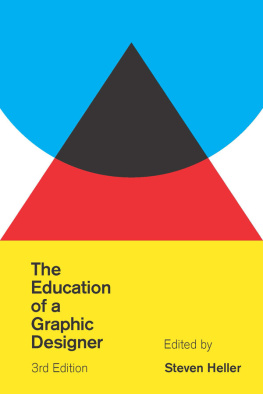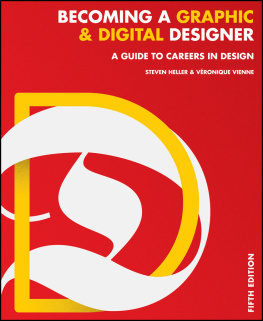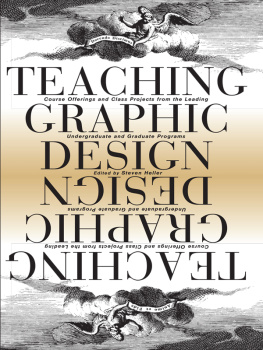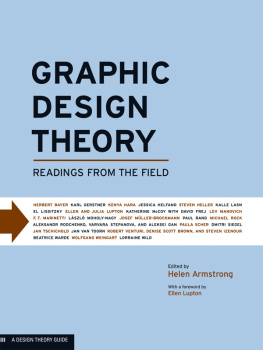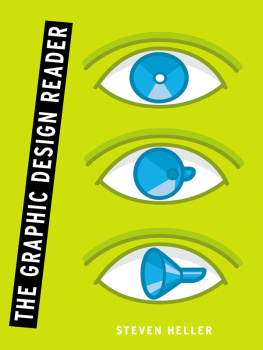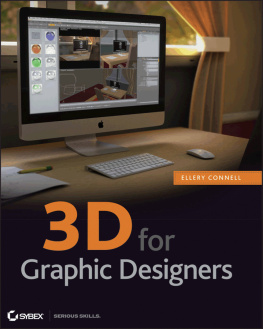Copyright 1998, 2005, 2015 by Steven Heller
All rights reserved. Copyright under Berne Copyright Convention, Universal Copyright Convention, and Pan American Copyright Convention. No part of this book may be reproduced, stored in a retrieval system, or transmitted in any form, or by any means, electronic, mechanical, photocopying, recording or otherwise, without the express written consent of the publisher, except in the case of brief excerpts in critical reviews or articles. All inquiries should be addressed to Allworth Press, 307 West 36th Street, 11th Floor, New York, NY 10018.
Allworth Press books may be purchased in bulk at special discounts for sales promotion, corporate gifts, fund-raising, or educational purposes. Special editions can also be created to specifications. For details, contact the Special Sales Department, Allworth Press, 307 West 36th Street, 11th Floor, New York, NY 10018 or .
19 18 17 16 15 5 4 3 2 1
Published by Allworth Press, an imprint of Skyhorse Publishing, Inc.
307 West 36th Street, 11th Floor, New York, NY 10018.
Allworth Press is a registered trademark of Skyhorse Publishing, Inc., a Delaware corporation.
www.allworth.com
Cover and interior design by The Collected Works
Library of Congress Cataloging-in-Publication Data is available on file.
Print ISBN: 978-1-62153-483-9
Ebook ISBN: 978-1-62153-493-8
Printed in the United States of America.
Table of Contents
By Steven Heller
By Andrea Marks
By Meredith Davis
By Frank Baseman
By Gunnar Swanson
By Gunnar Swanson
By Ken Garland
By Leslie Becker
By Liz Danzico
By Vronique Vienne
By Victor Margolin
By Kenneth Hiebert
By Elizabeth Resnick
By Paul J. Nini
By Rob Giampietro
By Chris Pullman
Steven Brower
By Marian Bantjes
By Roy R. Behrens
By Scott Santoro
By Alice Twemlow
By Meredith Davis
By Prasad Boradkar
By Hank Richardson
By Ellen Mazur Thomson
By Virginia Smith
By Richard Hollis
By Kerri Steinberg
By Leslie Atzmon
By Rob Giampietro
By Nancy Mayer
By Andrew Blauvelt
By Johanna Drucker
By Rick Poynor
By William Longhauser
By Chris Pullman
By Steven Heller
By Susan Agre-Kippenhan and Mike Kippenhan
By Jeffrey Keedy
By Chuck Byrne
By Carla Diana
By Katie Salen
By Max Bruinsma
By Michael Worthington
By Michael Rock
By Warren Lehrer
By Ellen Lupton
By Thomas Brigggs
By Richard and Judith Wilde
By Thomas Wedell and Nancy Skolos
By Lama Ajeenah
By Chris Pullman
By Leslie Atzmon
By Sagi Haviv
By Michael Golec
By Danny Lewandowski
By Heather Corcoran
By Mark Kingsley
By Robert Appleton
By Colin Berry
By Ellen McMahon and Karen White
By Audrey Bennett
By Katherine McCoy
By Steven Heller
Acknowledgments
Thanks to David Rhodes, president of the School of Visual Arts (SVA) New York, and Tad Crawford, publisher of Allworth Press, for their continued support and encouragement with this long-running Education of series. The Education of a Graphic Designer was the first (and at the time the only) title and now it is in its third edition.
For this, I owe a debt to all the educators who so generously contributed to this and the previous editions. Their respective commitments to designers and design education makes this a valuable document for student and teacher alike.
I also am grateful to my colleagues at SVA MFA Design / Designer as Author + Entrepreneur, Lita Talarico (co-chair), Esther Ro-Schofield, and Ron Callahan for everything theyve added to our design students lives.
Thanks to Justin Colt and Jose Fresneda of The Collected Works for their wonderful design work.
And to Louise Fili for keeping me educated.
Steven Heller
Introduction: Much Left to Learn
Steven Heller
There is, I believe, a Hollywood movie analogy for just about everything. Take Gravity, the 2013 Oscar Awardwinning film about how even the most highly educated operator of the most technologically advanced flying machine in the universe can be bollixed by garbage. The greatest threat to life and limb is all that supersonic flying junk sent into the atmosphere in the name of technology and commerce. Gravity is a parable about the future of graphic design, which is at the mercy of technological and commercial innovations beyond its current control.
So massive are these changes that how to educate designers for the present, no less the future, can be as complicated as when Gravity s Matt Kowalski (George Clooney), the wise old-middle-aged astronaut, attempts to get Dr. Ryan Stone (Sandra Bullock) back to Earth in one piece after she was cut adrift from her space station by hurtling satellite debris.
Like space junk, are digital medias smashing into old verities of graphic design? Designers, by and large, have more expert techno skill sets, but at what expense? UX and data viz designers are in more demand by industry when it comes to pushing data into digital space, which raises the question of how best to impart knowledge and what knowledge should indeed be imparted to students of these disciplines. Is fine typography and expert image direction and manipulation still the primary directives they once were? Or is code the new type? Can design be judged by time-honored aesthetic standards or is what we call graphic design destined to be viewed through anti-aesthetic lenses?
I wrote in the introduction to the second edition of this book in 2005:
Design pedagogy long ago moved out of the proverbial one-room schoolhouse onto a labyrinthine campus of departments and workshops awarding degrees and honors. In fact, considerable time has gone by since the formal word pedagogy was substituted in certain circles for the more pedestrian (though straightforward) teaching. Which is not a complaint, mind you, but an observation that design education has a lofty status now. It means that in many institutions it is no longer adequate to simply have a marketable portfoliograduates must acquire bona fides through internships, apprenticeships, work studies, and anything else that bulks their rsums. They must have certificates, diplomas, degrees, awards, and scads more evidence that they are designers with a capital D rather than mere mouse-pushers.
Still, there is a lot more to learn about capital D graphic design since 2005. This third edition of The Education of a Graphic Designer examines the field as it was, is, and may even become. Since 2005, competitive trans-media programs have proliferated in schools large and small, especially in the postgraduate space. Indeed, more postgraduate programs are available that provide integrated programs, many of which emphasize the current marriages of technology, business, and strategy with traditional and new design disciplines. The job market is hungry for designers who know the new tools and old skills. For instance, writing and research are increasingly more integral to a well-rounded career.
Unlike degree programs for professions governed by established standards and standardized tests (i.e., law, medicine, engineering, psychology, economics), I wrote in the second edition, graphic designwhich does not, and perhaps may never, necessitate board-tested certificationhas very few strict curriculum conventions and hardly any blanket requirements (other than knowing the computer and being fluent in type). Basic undergraduate design programs offer more or less the same basic courses, but levels of teaching excellence vary between institutions. More and more, I hear that teachers, particularly faculty who are practicing designers, want to be part of institutions where the students have proven levels of skill and talent. Time is too short to simply tutor those who either cannot or will not achieve what might be described as a new standard of design proficiency. The new requisites for designers (and the definition thereof) demands that standards be established. Some of the contributors to this edition overtly and covertly address what they should be.

